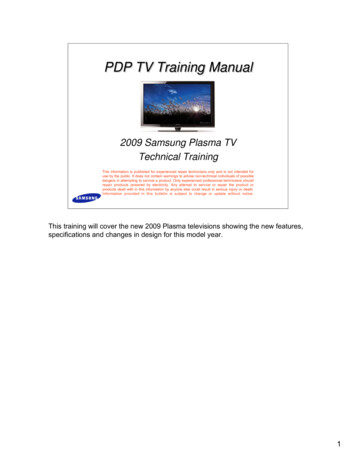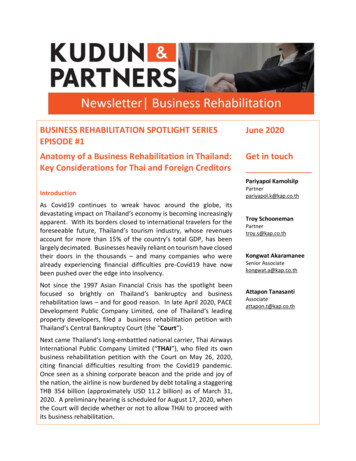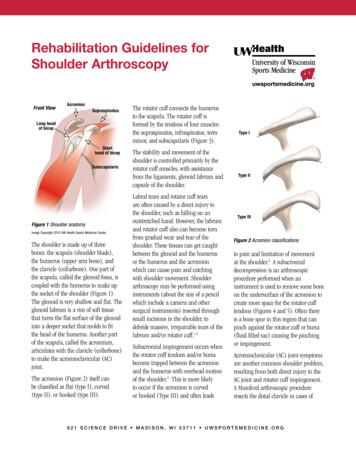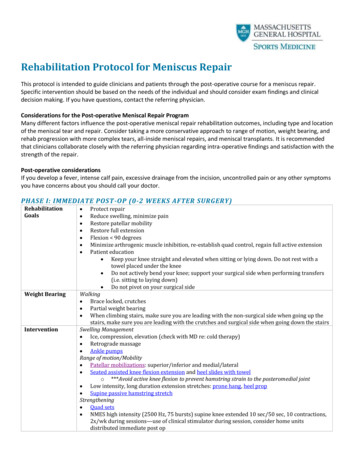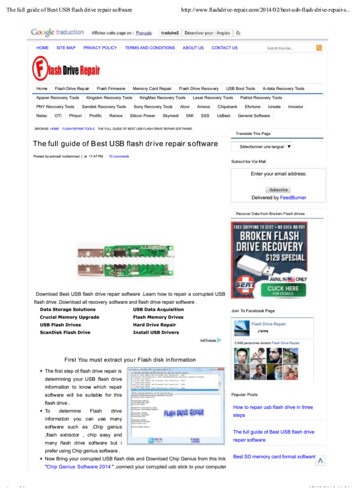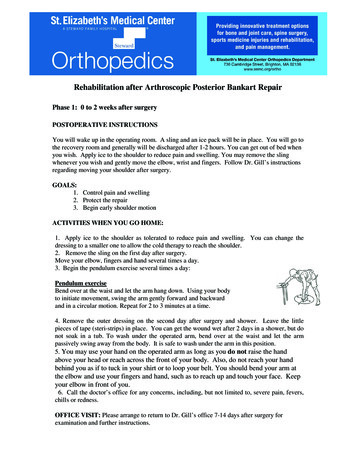
Transcription
Rehabilitation after Arthroscopic Posterior Bankart RepairPhase 1: 0 to 2 weeks after surgeryPOSTOPERATIVE INSTRUCTIONSYou will wake up in the operating room. A sling and an ice pack will be in place. You will go tothe recovery room and generally will be discharged after 1-2 hours. You can get out of bed whenyou wish. Apply ice to the shoulder to reduce pain and swelling. You may remove the slingwhenever you wish and gently move the elbow, wrist and fingers. Follow Dr. Gill’s instructionsregarding moving your shoulder after surgery.GOALS:1. Control pain and swelling2. Protect the repair3. Begin early shoulder motionACTIVITIES WHEN YOU GO HOME:1. Apply ice to the shoulder as tolerated to reduce pain and swelling. You can change thedressing to a smaller one to allow the cold therapy to reach the shoulder.2. Remove the sling on the first day after surgery.Move your elbow, fingers and hand several times a day.3. Begin the pendulum exercise several times a day:Pendulum exerciseBend over at the waist and let the arm hang down. Using your bodyto initiate movement, swing the arm gently forward and backwardand in a circular motion. Repeat for 2 to 3 minutes at a time.4. Remove the outer dressing on the second day after surgery and shower. Leave the littlepieces of tape (steri-strips) in place. You can get the wound wet after 2 days in a shower, but donot soak in a tub. To wash under the operated arm, bend over at the waist and let the armpassively swing away from the body. It is safe to wash under the arm in this position.5. You may use your hand on the operated arm as long as you do not raise the handabove your head or reach across the front of your body. Also, do not reach your handbehind you as if to tuck in your shirt or to loop your belt. You should bend your arm atthe elbow and use your fingers and hand, such as to reach up and touch your face. Keepyour elbow in front of you.6. Call the doctor’s office for any concerns, including, but not limited to, severe pain, fevers,chills or redness.OFFICE VISIT: Please arrange to return to Dr. Gill’s office 7-14 days after surgery forexamination and further instructions.
St. Elizabeth's Medical CenterOrthopedics Department736 Cambridge Street Brighton, MA 02135www.semc.org/orthoRehabilitation after Arthroscopic Posterior Bankart RepairPhase One: 5 to 6 weeks after surgeryGoals: Gradual increase in ROM Improve strength Decrease pain/inflammation Protect the labrum repairActivities:1. SlingThe sling is no longer necessary.2. Use of the operated armYou may now carefully use your arm. Avoid having the arm forcefully pulled behind youor across your chest in front of you. Continue to avoid heavy weight lifting or manuallabor. Follow any further instructions given to you by your doctor.3. PrecautionsYou may use your hand on the operated arm as long as you do not raise the hand aboveyour head or reach across the front of your body. Also, do not reach your hand behindyou as if to tuck in your shirt or to loop your belt. You should bend your arm at the elbowand use your fingers and hand, such as to reach up and touch your face. Keep your elbowin front of you. Do not bear the weight of the body on your arm.4. IceUse ice or cold as necessary 15-20 minutes.STRETCHING / ACTIVE MOTIONDays per week: 7 Times per day: 1-3Program:Pendulum exercisesSupine External RotationHands-behind-head stretchStanding external rotation stretchSupine forward flexion:Limit 140º week 6STRENGTHENING EXERCISESDays per week: 7Times per day: 1Theraband internal and external rotation:(internal rotation to neutral only)Standing forward flexion to 90 (scaption)Prone rowProne extensionBiceps curlSidelying external rotation
St. Elizabeth's Medical CenterOrthopedics Department736 Cambridge Street Brighton, MA 02135www.semc.org/orthoRehabilitation after Arthroscopic Posterior Bankart RepairPhase Two: 7 to 12 weeks after surgeryGoals:1. Protect the shoulder repair2. Regain full range of motion3. Continue gradual strengtheningActivities:1. Use of the operated armYou may now use your arm in a more normal fashion. You may move the arm into allpositions including behind the back if it is comfortable. Avoid having the arm forcefullypulled behind you, pulled across the chest or bearing weight as if doing a push-up.Continue to avoid heavy weight lifting or manual labor. Follow any further instructionsgiven to you by your doctor.2. PrecautionsDo not lift heavy objects overhead with the weight going behind the head. In otherwords, keep objects in front of you where you can see them.Exercise Program:STRETCHING / RANGE of MOTIONDays per week: 7 Times per day: 1-2STRENGTHENING / THERABANDPendulum exercisesDays per week: 7 Times per day: 1External rotation @90 abduction stretchWall slide StretchExternal RotationHands-behind-head stretchInternal RotationStanding external rotation stretchStanding Forward PunchStanding Forward FlexionShoulder ShrugBehind the back internal rotation: starts after theDynamic hug8th week after surgeryHorizontal adduction stretch: starts after the 8th “W”’sweek after surgerySeated RowBiceps curl
4STRENGTHENING / DYNAMICDays per week: 7 Times per day: 1Side-lying External RotationProne Horizontal Arm Raises ‘T’sProne scaption ‘Y’Prone rowProne extensionStanding forward flexion “full-can” exerciseRhythmic stabilization and proprioceptivetraining drills with physical therapist
St. Elizabeth's Medical CenterOrthopedics Department736 Cambridge Street Brighton, MA 02135www.semc.org/orthoRehabilitation after Arthroscopic Posterior Bankart RepairPhase Five: 13-20 weeks after surgery onwardGoals:1. Progression of functional activities2. Maintain full range of motion3. Continue progressive strengtheningExercise Program:STRETCHING / RANGE OF MOTIONDays per week: 5-7 Times per day: 1Continue all exercises from phase 4STRENGTHENING / THERABANDDays per week: 3 Times per day: 1Continue from phase 4STRENGTHENING / DYNAMICDays per week: 3 Times per day: 1Continue from phase 4PLYOMETRIC PROGRAMDays per week per physical therapistMay process weight bearing program: Ball on wall Pushup on unstable surfaceWEIGHT TRAININGDays per week per physical therapistSee weight training precautions sectionMachine resistance (limited ROM):Latissimus dorsi pull downsSeated rowSeated bench press
St. Elizabeth's Medical CenterOrthopedics Department736 Cambridge Street Brighton, MA 02135www.semc.org/orthoGuidelines for Returning to WeightTraining After Arthroscopic LabrumRepairYou should not return to training usingheavy weights or on weight machines untilDr. Gill determines that it is safe. In general,it is usually safe to return to heavier weighttraining at three to four months followinglabrum repair.Before embarking on a weight-trainingprogram, you should have full range ofshoulder motion and normal strength in therotator cuff and scapular muscles. Thedoctor or a physical therapist will test yourmotion and strength before you start weighttraining.When starting your weight-training program,you can start with 3 sets of 15-20 repetitions.Training with high repetition sets ensuresthat the weights that you are using are nottoo heavy.NEVER perform any weight trainingexercise to the point of muscle failure.“Muscle failure” occurs when, in performinga weight training exercise, the muscle is nolonger able to provide the energy necessaryto contract and move the joint(s) involved inthe particular exercise. Joint, muscle andtendon injuries are more likely to occurwhen muscle failure occurs.The following weight training exercisesshould be avoided after Bankart repair forshoulder instability:1. Pull downs behind-the-neck (wide-grip)2. Behind-the-neck shoulder press3. Wide-grip bench press4. Standing lateral deltoid raises5. Triceps press overheadThe following exercises require specialcautions:1. Pull downs should only be done in frontof the head, to the chest, with a medium(notwide) grip.2. Shoulder press overhead should be donecarefully, avoiding heavy weights. If doingshoulder presses, always start with the hand infront of the shoulder and end overhead whereyou can still see your hand. For persons usingbarbells, this is the “military press”.3. If bench pressing, your grip should be no widerthan the wider than the width of your shoulders.Avoid any exercises using grips wider ornarrower than shoulder width.4. Lateral deltoid raises should be avoided becauseof the impinging and wearing effect on therotator cuff. Forward raises in the “thumb-up”position are usually safer and can be done withreasonable weights. Lateral raises from theprone or bent over position can be done as asubstitute for standing lateral deltoid raises.5. When doing incline bench press with barbells,there is a danger of shoulder dislocation if thelifter loses control of the bar when returning thebarbell to the rack of the incline bench. Alwayshave a spotter for removing and replacing thebarbell in this exercise.6. If you are doing any type of “chest-fly”, keep inmind the following precautions.Do not do any chest-fly exercise with straightelbows. Always allow the elbows to bend andnever lower your hands (holding dumbbells)below the level of your chest.7. If you are using a “Pec-Deck” machine, never letthe weight stretch the arms so that your elbowspass behind your chin. You can set the arms onthis machine a few clicks forward to adjust themaximum motion allowed.8. If you a performing “dips” using a set of parallelbars, never lower yourself below the point wherethe elbows reach a 90-degree angle.9. For triceps exercises, triceps pushdowns on apulley system are safe as well as bent-overtriceps extensions.10. When doing the upright-rowing exercise, keepyour grip at least 12 inches apart. When pullingthe bar upward toward the chin, do not raise thebar higher than the point at which the elbowreaches shoulder level.
St. Elizabeth's Medical CenterOrthopedics Department736 Cambridge Street Brighton, MA 02135www.semc.org/orthoExercises Usually Problem-Free1. Biceps Curls2. Cable and bent-over rowing3. Shoulder shrugsIf your goal is returning to high-level weighttraining or weight lifting, it will take 3 to 6months of cautious, gradual progression toreturn to top form. In general, avoidincreasing the amount of weight lifted bymore than 10-15% (at a time) of your presentworking weight every 10-14 days.Remember: Weight training is beneficial toimprove muscular strength and protect thejoints from injury. If done improperly byusing too much weight and/or impropertechnique, weight training can cause seriousinjury.
St. Elizabeth's Medical CenterOrthopedics Department736 Cambridge Street Brighton, MA 02135www.semc.org/orthoRehabilitation after Arthroscopic Posterior Bankart RepairPhase Four: 21-28 weeks after surgery onwardGoals:1. Progression of functional activities4. Maintain full range of motion5. Continue progressive strengtheningSTRETCHING / RANGE OF MOTIONDays per week: 5-7 Times per day: 1Continue all exercises from phase 5STRENGTHENING / THERABANDDays per week: 3 Times per day: 1Continue from phase 5STRENGTHENING / DYNAMICDays per week: 3 Times per day: 1Continue from phase 5PLYOMETRIC PROGRAMDays per week per physical therapistMay process weight bearing program: Rebounder’ throws with arm at side Wall dribbles overhead Rebounder throwing/weighted ball Deceleration drills with weighted ball Wall dribbles at 90 Wall dribble circlesWEIGHT TRAININGDays per week per physical therapistSee weight training precautions sectionProgress per MD instructionsINTERVAL SPORT PROGRAMS at 28 to 32 weeksSee individual programs for golf, tennis, swimming and throwing.
St. Elizabeth's Medical CenterOrthopedics Department736 Cambridge Street Brighton, MA 02135www.semc.org/orthoPost-op phaseSlingPhase 10 to 4 weeks after surgeryGoals:*Allowhealingrepaired capsule.ofPer MDinstructions.Per MDinstructions.*Initiate early protected andrestricted range of motion.*Minimize muscularatrophy.Range of Motion*Flexion to 120degrees as tolerated*ER @ 0º totolerance,*ER@ 90º totolerance*No IR behind back,*No IR@90º,*No horizontaladductionTherapeutic exercisesNo stretching 0-4*Isometrics: ER, IR,weeksFLX, EXT, ABD*Pendulum exercises*Supine forwardflexion with wand*Supine ER atneutral*Scapular retractionwith ER*Decreasepain/inflammation.At 5-6 weeks:IR in plane ofscapula: 30º5 to 6 weeks after surgeryGoals:*Flexion to 120º astolerated*Gradual increase in ROMAt 5-6 weeks:Standing ERNstretch*Improve strengthPhase 2Goals:*Gradually restore range ofmotion*Increase strength*Improve neuromuscularcontrol*Enhance proprioceptionand kinesthesia*Rythmic stabilizationfor IR/ER, FLX/EXTNo horizontaladduction*Propriocetion drillsNo closedchain positions*Ball squeeze*Elbow and forearmexercisesNo activitiesabove head.At 5-6 weeks:*Side lying ER*Prone row*Prone extension* Standing forwardflexion to 90º*Biceps curl*Theraband exercisesER, IR (limit IR toneutral)*Decreasepain/inflammation7 to 12 weeks after surgeryPrecautionsNo internalrotationD/C*ERat90º *Gradually improveabductionto ROM all planestolerance (shouldbe 85-90º by *Rope and pulley:week 8)*Shoulder flexion totolerance (165 º byweek 8)*IR in plane ofscapula: 60*IR at 90º abductionto 30-45º week 10Progress cautiouslyand gradually to 6065º by week 12*ER @ 90º progressto 90 (110-115º forthrowers)*Elevation inscapular planeTheraband exercises:,Continue phase1Add Shrug, Dynamichug, ‘W’s.Biceps curlRowForward punch(serratus punch)*Wall slide*IR behind back tobeltline only*Horizontaladduction reach only*Hands behind-thehead stretch*ER @ 90ºabduction stretchDynamic exercises:PRE 1-3 lb as toleratedContinue phase1Add:*Side-lying scaption*Prone ‘T’s*Standing scaption*Isotonic biceps curl*Prone ‘Y’s*Rhythmic stabilization*Propriocetion drills*ScapulohumeralRhythm exercisesGradual ROMfor IR behindback, IR at 90ºabduction andhorizontaladductionNo push-upsor pushingmovements
St. Elizabeth's Medical CenterOrthopedics Department736 Cambridge Street Brighton, MA 02135www.semc.org/orthoPost-op PhasePhase 2continuedTherapeutic Exercises*Transition IRgradually fromplaneofscapulatocoronal plane*Progress IR to60-65 degreesat 90 degreesabduction byweek 12Phase 313-20 weeks after surgeryGoals:* Progress to full ROM*Improve:strength/power/endurance*Improve neuromuscular control*Improve dynamic stability*Improve scapular muscularstrengthPhase 421-28 weeks after surgery onwardGoals:Progressively increase activities toprepare patient for unrestrictedfunctional return*Progressfull ROMto*Side lying IR @90º limit 60 to 65ºat week 12 andfull by week 20.*Horizontaladduction stretch*IRbehindback fullFull ROMTheraband: add ‘T’s,diagonal up and down,External rotation at 90 ,Internal rotation at 90 Return toSportsNot yetPrecautionsContinue to avoidexcessive orforceful horizontaladduction andinternal rotationDynamic:*Continue previous*Initiate push-ups into wall atweek 12 (then push-upprogression per MD)*Emphasize muscle strengthof ER, scapular region*Continue theraband and Gradual return todynamic exercises from recreationalactivitiesphase 1 and 2*Weight training canbegin.See weight trainingprecautions.*Machine resistance (limitedROM):*Front pull downs*Seated row*Seated bench press at week16*May progress CKC program:Ball on wallPushup on unstable surfaceat 20 weeksPlyometric exercises:*Rebounder throws arm atside*Wall dribbles overhead*Rebounder throws withweighted ball,*Decelerations, wall dribblesat 90º*Wall dribble circlesInterval sportsprograms canbegin between28-32 weeks.Strength athletescan graduallyresume regulartrainingWeight trainingprecautions.Shoulder bracesometimes forcollision sports.
Before embarking on a weight-training program, you should have full range of shoulder motion and normal strength in the rotator cuff and scapular muscles. The doctor or a physical therapist will test your motion and strength before you start weight training. When starting your weight-training program, you can start with 3 sets of 15-20 repetitions.


